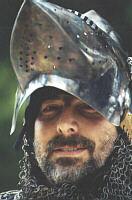Journal of Western Martial Art
Volume 2003
Archived Articles
| 10/03 | Stephen Hand - The Practical Saviolo - Part 5
This is the last in a series of annotated sections of Vincentio Saviolo's "His Practise. In Two Bookes." and presents a discourse on single rapier. It was originally published in Hammerterz Forum Vol. 5 No. 2 & 3. |
| 08/03 | Stephen Hand - The Practical Saviolo - Part 4
This is the fourth in a series of annotated sections of Vincentio Saviolo's "His Practise. In Two Bookes." It was originally published in Hammerterz Forum Vol. 5 No. 1. |
| 06/03 | Michael Rasmusson - Blossfechten and the Fechtschulen - German Judicial and Sport Dueling from the Dark Ages to the Renaissance
An in-depth look at the development and the relevance of the German fencing school or "fechtschule" form of fencing bouts from its roots before the 14th century to 17th century to the challenges faced today with holding and administering unarmoured longsword fencing bouts which remain within the spirit of the earlier fechtschule principles. |
| 06/03 | J. Christoph Amberger - Sword and Buckler Fighting among the Lost Crusaders
A fascinating account by an American visitor by the name of Richard Halliburton (1900-1939) of the existence of possible lost crusaders in the remote regions of the Caucasus area. This area cut off from the rest of the world with 9 months of ice and snow may have provided the necessary isolation to maintain the fighting styles of the crusaders for hundreds of years. |
| 06/03 | Matt Galas - The Flower of Battle - A Medieval Italian Fencing Manual
The article examines a manuscript, written in 1410 by a swordsmaster by the name of Fiore dei Liberi, providing details of Liberi's past, brief examination of self defence against a knife (dagger), longsword, armoured combat and mounted combat. |
| 05/03 | Frank Docherty - English Martial Arts
The article briefly examines the history and culture behind English martial arts and its variations such as bare knuckle boxing, broadsword, sword and dagger, sword and buckler, backsword and quarterstaff. |
| 05/03 | Stephen Hand - The Practical Saviolo - Part 3
This piece picks up with Vincentio describing techniques possible from the short ward, a variant of the low ward in which the hand is held by the right side, with the rapier directed at the opponent's face. |
| 05/03 | J. Christoph Amberger - Behind the woodshed: Little-known aspects of Dussack play through the ages
An exploration of one of the most bizarre German sports fencing weapons, apparently in use for a couple of hundred years since the 1400's and was the dominant training weapon used in the German fechtschulen during the 16th century, outstripping the use of longsword, staves and daggers. |
| 04/03 | H. A. Colmore Dunn - Fencing, Old and New. As Typified by Angelo and Prévost.
Originally published in Outing magazine, October 1894, the article offers an interesting perspective of the perception of early historical fencing (17th - 18th century) from the viewpoint of the late 19th century at the time this article was written, in which strength rather than skill was the order of the day for swordsmen wielding the rather "cumbersome" rapier, and who neglected the point of ths sword resulting in wild and imaginative swordplay. |
| 04/03 | J. Christoph Amberger - Reconstructing Ancient Martial Arts
Christoph takes a winding trail of a series of brief explorations of some historical sources describing early martial arts traditions of the Eastern and Western cultures, brief examination of Western fighting art styles that we have come to expect from the Asian arts, the "perfect" sword blade construction and the lethal and systematic Western fighting arts buried in the often times illustrated documentation (treatises) by the masters of the period. |
| 04/03 | Stephen Hand - The Practical Saviolo - Part 2
Continuing with part #2 of series of annotated sections of Vincentio Saviolo's "His Practise. In Two Bookes.", Stephen picks up where Vincentio has just finished describing the fourth sequence commencing from the extended Low Ward. |
| 04/03 | Letters to the Editor - Latest Letter: Great Collection of Articles (M.Rasmusson) - April 29, 2003 |
| 03/03 | J. Christoph Amberger - A Fechtschule in late 16th-Century Germany
An engaging 16th century description on the German fechtschule or fencing school originally written in "Kufahl, Hans and Schmied-Kowarzik, Josef. Fechtbüchlein, Leipzig: Reclam, 1894" provides the reader a glimpse into the distinction between the exercise of arms on the fencing floor and the contests which were held publically. |
| 03/03 | Stephen Hand - The Practical Saviolo - Part 1
This is the first in a series of annotated sections of Vincentio Saviolo's "His Practise. In Two Bookes.", a rapier fencing manual published in England in 1595 and the first such work actually written in that country (albeit by a foreigner). |
| 03/03 | David M. Cvet - Editor's Note
This is my first editor's note written for the Journal of Western Martial Art and it is about time. As an editor, I've been rather silent in my responsibilities towards this online journal, even though work has been occuring throughout the life of this journal, not entirely visible to the reader. |
Book & Video Reviews
| 11/04 | David M. Cvet - The Crooked Stick
Hugh D.H. Soar's latest book, "The Crooked Stick" is a comprehensive study and presentation of the amazing history of the traditional longbow. The longbow, a pivotal technical development by mankind, had influenced the survival of humankind, as well as the outcome of battles from the earliest days of the medieval period, well into the period of Tudor monarchy till the opening of the 17th century. |
| 11/04 | Murray Eiland - Gladiators and Caesars
The book was designed to accompany an exhibition at the British Museum - originally at the Museum für Kunst und Gewerbe in Hamburg - held between 21 October 2000 to 23 January 2003, it belongs on the shelf of anyone interested in historical combat. Translated from German, it presents up to date research that has hitherto not been widely available in English. It covers combat arts, Greek sports, chariot racing, and the theatre. Pride of place is, as the title suggests, given to gladiators. |
| 10/04 | David M. Cvet - Italian Rapier Combat - Ridolfo Capo Ferro
Ridolfo Capo Ferro, master of the Italian rapier, whose work is based on over 200 years of Italian fencing tradition, published the original treatise in 1610, almost exactly 200 years after the first known Italian fencing treatise by the great fencing master, Fiore dei Liberi, presents to the practioner, access to the foundations of fencing so difficult to extract from historical treatises. This publication now unlocks the original treatise and makes available to every practitioner the eloquent nature and elements of Italian rapier fencing. |
| 05/03 | Tony Wolf - LArte di dar Contraria
This Italian video is a semi-dramatised exploration of the Italian martial arts as interpreted by Nova Scrimia, a society dedicated to the revival of this tradition. All of the narration is subtitled in English and the translation is of a high standard. Nova Scrimia and their production associates have succeeded in crafting an entertaining documentary that will appeal to historical fencers, martial artists and aficionados of Italian culture and history. |
| 11/02 | David M. Cvet - Codex Wallerstein: A Medieval Fighting Book from the Fifteenth Century on the Longsword, Falchion, Dagger, and Wrestling
The Codex Wallerstein is one of the most comprehensive manuscripts depicting early European martial arts. Written in high middle German during the late 14th century and early 15th century, the codex has remained in obscurity for generations at the Augsburg University (I.6.40.2) available to only the local scholars for study and research purposes. |
| 10/01 | Edward Chart - English Martial Arts, by Terry Brown
Terry Brown's book "English Martial Arts" provides the reader with a window into the little known history of English martial arts. First published in 1997, this book capitalizes on a growing interest in resurrecting ancient European martial arts in the West, a trend which has been on the rise over the last decade. |
Feedback
You are welcome to contact the editor, David Cvet with or to submit via email, "". Letters to the editor will be published in the above listing in a similar fashion as articles submitted.
Please include your name, city, prov/state with your letter and indicate whether or not your email addy can be included in your letter online.
Resources
- You can find more information on medieval fighting arts at the Academy of European Medieval Martial Arts website or to view an extensive online library of medieval fighting arts treatises visit the AEMMA Online Library.
The Editors
, Executive Editor - JWMA and JManly
David is the Founder and President of the Academy of European Medieval Martial Arts (AEMMA), an organization dedicated to the resurrection and formalization of medieval martial arts training systems. He received training in Milan, Italy employing steel weapons in longsword techniques and has participated in various organizations dedicated to studying the Middle Ages. His background and experience having fired his desire to pursue a formal medieval martial arts training program, he founded AEMMA in mid-1998. He is a member of the advisory board of the Swordplay Symposium International (SSI), an interdisciplinary colloquium of historical fencing specialists dedicated to promoting and advancing the study of Western swordsmanship, and participating board member of the Association for Historical Fencing (AHF). David received his appointment of free scholler in Oct, 2000 and the "Acknowledged Instructor" (AI) designation for armoured combat instruction in Oct, 2000 by the International Masters at Arms Federation (IMAF).
, Editor - JManly
Tony is a professional fight director and martial arts/stage combat tutor. Since 1978 he has traversed a wide range of Asian, Polynesian and European martial arts, with a particular interest in both European "folk styles" and the combatives of the late 1800s. He was a pioneer of padded-attacker self-defence training in his home country of New Zealand and serves as an advisor for several international martial arts and stage combat organisations.
Tony's fight direction and action sequences have been featured in over one hundred and seventy feature film, television, theatre, opera and ballet productions. Between 1998-2000 he served as the Fighting Styles Designer for Peter Jackson's Lord of the Rings movie trilogy and in 2002 he toured Japan with the Washington Opera Company's production of Otello starring Placido Domingo. Tony has taught, directed and performed throughout New Zealand, as well as in Australia, the USA, England, Ireland, Canada and Japan. He lives in Wellington, New Zealand with his son, Josh.
EJMAS Copyright © 2003 All Rights Reserved ISSN 1492-1642

